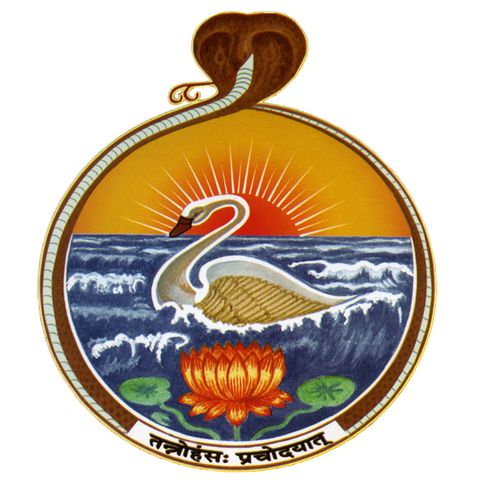82 - Rhythmic Cycle of Life and Cosmos | Swami Tattwamayananda

Download and listen anywhere
Download your favorite episodes and enjoy them, wherever you are! Sign up or log in now to access offline listening.
Description
-8th chapter: verses 17, 18, 19, 20, 21 -The lecture was given by Swami Tattwamayananda on May 14, 2021. -17th verse deals with the Hindu concept of Cosmogony, according to...
show more-The lecture was given by Swami Tattwamayananda on May 14, 2021.
-17th verse deals with the Hindu concept of Cosmogony, according to which cosmic movement is in rhythmic cycles.
-According to Yuga theory, there are four Yugas - Satya, Dvapara, Treta and Kali Yuga. Satya Yuga is 1 million and 28,000 years. Treta Yuga is 1 million and 3,000 years. Dwapara Yuga is 854,000 years. Kali Yuga is 429,000 years. These four Yugas together constitute a Mahayuga, and 1000 Mahayugas constitute a Kalpa. One full day and night of Brahma is equal to 2000 yugas. At Pralaya, these four Yugas get dissolved.
-The theme of verses 17-21 is the following. Cyclicism applies to both human life and the cosmos. Just as the tree exists in a seed in an involved (unmanifested) state, similarly, the cosmos comes from a state of non-manifestation to a state of manifestation. After many years, it goes back to its unmanifested state. After trillions of years, manifestation begins again. This goes on in cycles. The manifested (Vyakta) and unmanifested (Avyakta) belong to the realm of the relative. Beyond these, there is the unmanifested reality that is Aksharam (imperishable) and Sanatana (eternal).
-There are three schools of thought on cause-effect relationship in Indian philosophy. According to Sanghatavada, things come into existence when different parts come together. For example, a chair comes into existence by combining several parts. According to Arambhavada, every effect is a new creation, and the effect does not pre-exist in the cause (Asatkaryavada). For example, a cloth made of threads has a new existence that is different from the threads. According to Vedanta and Bhagavad Gita, the effect pre-exists in the cause (Satkaryavada). For example, the cloth pre-exists in the thread – it just gets a new name and form.
-Our life begins long before we are born, and our life will continue long after we are dead. Life is only a transition. We continue going through these revolving cycles, until we realize the supreme truth, that we are one with the supreme reality that does not belong to the realm of the relative.
-17th and 18th verses: “The whole cosmos exists in two states – the undifferentiated (Avyakta) and differentiated (Vyakta) – both these states belong to the relative. The differentiated state will go back to the undifferentiated state. When the day of Brahma begins, creation begins. When the day of Brahma ends, dissolution takes place.”
-The day of Brahma represents the cosmic mind. Creation is symbolically compared to the dawn of the cosmic mind. Dissolution of the created universe corresponds to the sunset of the cosmic mind.
-The universe has two dimensions – Vyakta and Avyakta. The earth evolved into a state (Vyakta) where living conditions became appropriate for living creatures to evolve and survive. These living conditions may disappear after millions of years - the earth will then merge back to its unmanifested state (Avyakta).
-19th verse: “The same variety of different beings that existed in the preceding day of Brahma, they merge when the night comes. And then they manifest again at daybreak – the morning of Brahma’s day.”
-20th and 21st verse: “Beyond this Avyakta (unmanifested) and Vyakta (manifested), which belong to the realm of the relative, there is the one Absolute Reality which is different from the unmanifested state of the relative – it is Aksharam (imperishable) and it is Sanatana (eternal). Those who realize their spiritual identity with this Supreme Reality, they get liberation from this cyclic rotation”
-Everything moves in cycles – both in human life and in the cosmos. In human life, there is a cause and effect link between our lives. When a person dies, the senses of perception and action disappear, but the samskaras transmigrate in seed form, and manifest in the next life. At the Cosmic level, from the Avyakta state, the Vyakta state comes. The same Vyakta state later goes back to the Avyakta state. The causal dimension is Avyakta. The effect dimension is Vyakta.
-When we are in the realm of the relative, we think that time and space are eternal. Only when we get out of the relative, we realize that time and space are relative. With spiritual practices, we can transcend the relative.
-Silence is the language of the highest spiritual experience. Sri Ramakrishna said that one has to come down several steps from the highest state of samadhi to Omkara, then several steps down to Gayatri, and then several steps down to Vedas. This means that the highest truth can only be experienced – even Omkara does not explain this highest truth.
-When we evolve in spiritual life our questions cease to be questions. They self-destruct.
Information
| Author | Vedanta Society, San Francisco |
| Organization | Vedanta Society, San Francisco |
| Website | - |
| Tags |
Copyright 2024 - Spreaker Inc. an iHeartMedia Company

Comments